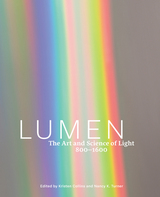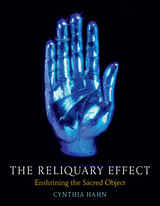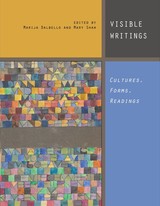4 books about Hahn, Cynthia

Lumen
The Art and Science of Light, 800–1600
Kristen Collins
J. Paul Getty Trust, The, 2024
Sumptuously illustrated with dazzling objects, this publication explores the ways art and science worked hand in hand in the Middle Ages and Renaissance.
Through the manipulation of materials, such as gold, crystal, and glass, medieval artists created dazzling light-filled environments, evoking, in the everyday world, the layered realms of the divine. While contemporary society separates science and spirituality, the medieval world harnessed the science of light to better perceive and understand the sacred. From 800 to 1600, the study of astronomy, geometry, and optics emerged as a framework that was utilized by theologians and artists to comprehend both the sacred realm and the natural world.
Through essays written by contributors from the fields of art history, the history of science, and neuroscience, and with more than two hundred illustrations, including glimmering golden reliquaries, illuminated manuscripts, rock crystal vessels, astronomical instruments, and more, Lumen cuts across religious, political, and geographic boundaries to reveal the ways medieval Christian, Jewish, and Islamic artists, theologians, and thinkers studied light. To convey the sense of wonder created by moving light on precious materials, a number of contemporary artworks are placed in dialogue with historic objects.
This volume is published to accompany an exhibition on view at the J. Paul Getty Museum at the Getty Center from September 10 to December 8, 2024.
Through the manipulation of materials, such as gold, crystal, and glass, medieval artists created dazzling light-filled environments, evoking, in the everyday world, the layered realms of the divine. While contemporary society separates science and spirituality, the medieval world harnessed the science of light to better perceive and understand the sacred. From 800 to 1600, the study of astronomy, geometry, and optics emerged as a framework that was utilized by theologians and artists to comprehend both the sacred realm and the natural world.
Through essays written by contributors from the fields of art history, the history of science, and neuroscience, and with more than two hundred illustrations, including glimmering golden reliquaries, illuminated manuscripts, rock crystal vessels, astronomical instruments, and more, Lumen cuts across religious, political, and geographic boundaries to reveal the ways medieval Christian, Jewish, and Islamic artists, theologians, and thinkers studied light. To convey the sense of wonder created by moving light on precious materials, a number of contemporary artworks are placed in dialogue with historic objects.
This volume is published to accompany an exhibition on view at the J. Paul Getty Museum at the Getty Center from September 10 to December 8, 2024.
[more]

The Reliquary Effect
Enshrining the Sacred Object
Cynthia Hahn
Reaktion Books, 2017
From skeletons to strips of cloth to little pieces of dust, reliquaries can be found in many forms, and while sometimes they may seem grotesque on their surface, they are nonetheless invested with great spiritual and memorial value. In this book, Cynthia Hahn offers the first full survey in English of the societal value of reliquaries, showing how they commemorate religious and historical events and, more important, inspire awe, faith, and, for many, the miraculous.
Hahn looks deeply into the Christian tradition, examining relics and reliquaries throughout history and around the world, going from the earliest years of the cult of saints through to the post-Reformation response. She looks at relic footprints, incorrupt bodies, the Crown of Thorns, the Shroud of Turin, and many other renowned relics, and she shows how the architectural creation of sacred space and the evocation of the biblical tradition of the temple is central to the reliquary’s numinous power. She also discusses relics from other traditions—especially from Buddhism and Islam—and she even looks at how reliquaries figure in contemporary art. Fascinatingly illustrated throughout, this book is a must-read for anyone interested in the enduring power of sacred objects.
Hahn looks deeply into the Christian tradition, examining relics and reliquaries throughout history and around the world, going from the earliest years of the cult of saints through to the post-Reformation response. She looks at relic footprints, incorrupt bodies, the Crown of Thorns, the Shroud of Turin, and many other renowned relics, and she shows how the architectural creation of sacred space and the evocation of the biblical tradition of the temple is central to the reliquary’s numinous power. She also discusses relics from other traditions—especially from Buddhism and Islam—and she even looks at how reliquaries figure in contemporary art. Fascinatingly illustrated throughout, this book is a must-read for anyone interested in the enduring power of sacred objects.
[more]

Saints and Sacred Matter
The Cult of Relics in Byzantium and Beyond
Cynthia Hahn
Harvard University Press
Enshrined in sumptuous metal, ivory, or stone containers, relics formed an important physical and spiritual bond between heaven and earth, linking humankind to their saintly advocates in heaven. As they were carried in liturgical processions, used in imperial ceremonies, and called upon in legal disputes and crises, relics—and, by extension, their precious containers and built shrines—provided a visible link between the living and the venerated dead. Saints and Sacred Matter explores the embodied aspects of the divine—physical remains of holy men and women and objects associated with them. Contributors explore how those remains, or relics, linked the past and present with an imagined future. Many of the chapters focus on the Christian context, both East and West, where relics testified to Christ’s presence and ministry on earth and established a powerful connection between God and humans after his resurrection. Other religious traditions from the ancient world such as Judaism and Islam are frequently thought to have had no relics, but contributions to this volume show that Muslims and Jews too had a veneration for the corporeal that is comparable to that of their Christian counterparts.
[more]

Visible Writings
Cultures, Forms, Readings
Dalbello, Marija
Rutgers University Press, 2011
Exploring the concept and history of visual and graphic epistemologies, this engrossing collection of essays by artists, curators, and scholars provides keen insights into the many forms of connection between visibility and legibility. With more than 130 color and black-and-white photographs, Visible Writings sheds new light on the visual dimensions of writing as well as writing's interaction with images in ways that affect our experiences of reading and seeing.
Multicultural in character and historical in range, essays discuss pre-Colombian Mesoamerican scripts, inscriptions on ancient Greek vases, medieval illuminations, Renaissance prints, Enlightenment concepts of the legible, and the Western "reading" of Chinese ideograms. A rich array of modern forms, including comics, poster art, typographic signs, scribblings in writers' manuscripts, anthropomorphic statistical pictograms, the street writings of 9/11, intersections between poetry and painting, the use of color in literary texts, and the use of writing in visual art are also addressed.
Visible Writings reaches outside the traditional venues of literature and art history into topics that consider design, history of writing, philosophy of language, and the emerging area of visual studies. Marija Dalbello, Mary Shaw, and the other contributors offer both scholars and those with a more casual interest in literature and art the opportunity, simply stated, to see the writing on the wall.
Multicultural in character and historical in range, essays discuss pre-Colombian Mesoamerican scripts, inscriptions on ancient Greek vases, medieval illuminations, Renaissance prints, Enlightenment concepts of the legible, and the Western "reading" of Chinese ideograms. A rich array of modern forms, including comics, poster art, typographic signs, scribblings in writers' manuscripts, anthropomorphic statistical pictograms, the street writings of 9/11, intersections between poetry and painting, the use of color in literary texts, and the use of writing in visual art are also addressed.
Visible Writings reaches outside the traditional venues of literature and art history into topics that consider design, history of writing, philosophy of language, and the emerging area of visual studies. Marija Dalbello, Mary Shaw, and the other contributors offer both scholars and those with a more casual interest in literature and art the opportunity, simply stated, to see the writing on the wall.
[more]
READERS
Browse our collection.
PUBLISHERS
See BiblioVault's publisher services.
STUDENT SERVICES
Files for college accessibility offices.
UChicago Accessibility Resources
home | accessibility | search | about | contact us
BiblioVault ® 2001 - 2024
The University of Chicago Press









